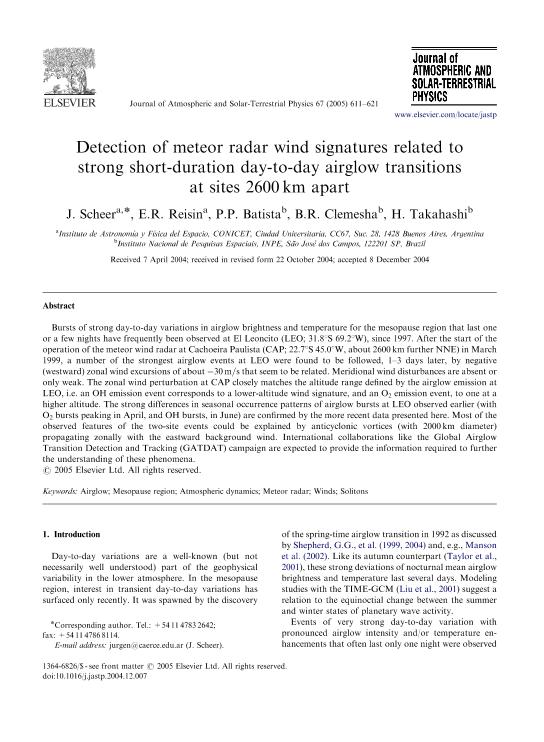Artículo
Detection of meteor radar wind signatures related to strong short-duration day-to-day airglow transitions at sites 2600 km apart
Fecha de publicación:
12/2005
Editorial:
Elsevier
Revista:
Journal of Atmospheric and Solar-Terrestrial Physics
ISSN:
1364-6826
Idioma:
Inglés
Tipo de recurso:
Artículo publicado
Clasificación temática:
Resumen
Bursts of strong day-to-day variations in airglow brightness and temperature for the mesopause region that last one or a few nights have frequently been observed at El Leoncito (LEO; 31.81S 69.21W), since 1997. After the start of the operation of the meteor wind radar at Cachoeira Paulista (CAP; 22.71S 45.01W, about 2600 km further NNE) in March 1999, a number of the strongest airglow events at LEO were found to be followed, 1–3 days later, by negative (westward) zonal wind excursions of about 30 m=s that seem to be related. Meridional wind disturbances are absent or only weak. The zonal wind perturbation at CAP closely matches the altitude range defined by the airglow emission at LEO, i.e. an OH emission event corresponds to a lower-altitude wind signature, and an O2 emission event, to one at a higher altitude. The strong differences in seasonal occurrence patterns of airglow bursts at LEO observed earlier (with O2 bursts peaking in April, and OH bursts, in June) are confirmed by the more recent data presented here. Most of the
observed features of the two-site events could be explained by anticyclonic vortices (with 2000 km diameter) propagating zonally with the eastward background wind. International collaborations like the Global Airglow Transition Detection and Tracking (GATDAT) campaign are expected to provide the information required to further the understanding of these phenomena.
Archivos asociados
Licencia
Identificadores
Colecciones
Articulos(IAFE)
Articulos de INST.DE ASTRONOMIA Y FISICA DEL ESPACIO(I)
Articulos de INST.DE ASTRONOMIA Y FISICA DEL ESPACIO(I)
Citación
Scheer, Jurgen; Reisin, Esteban Rodolfo; Batista, P. P.; Clemesha, B. R.; Takahashi, H.; Detection of meteor radar wind signatures related to strong short-duration day-to-day airglow transitions at sites 2600 km apart; Elsevier; Journal of Atmospheric and Solar-Terrestrial Physics; 67; 6; 12-2005; 611-621
Compartir
Altmétricas




